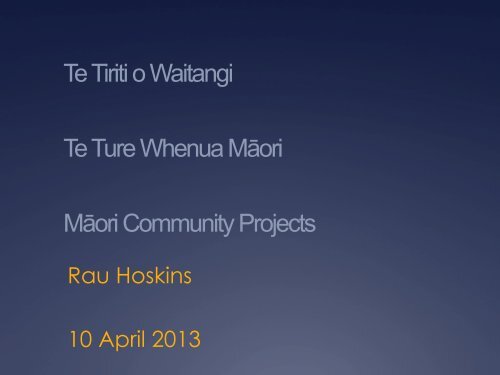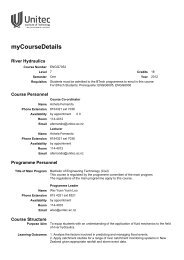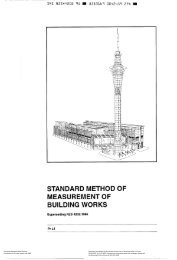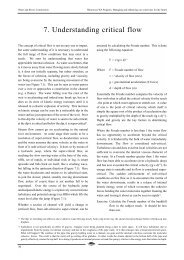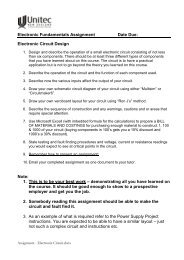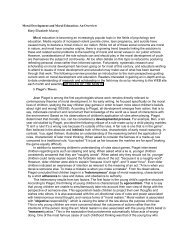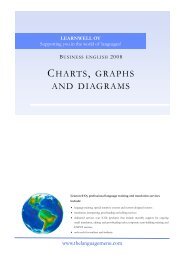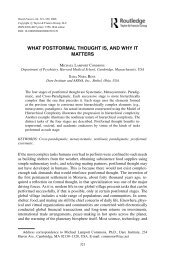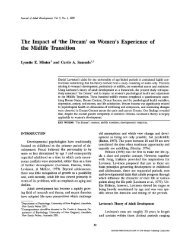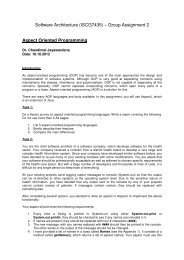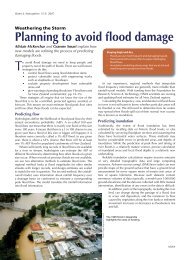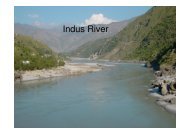Maori Law-Te Tiriti o Waitangi me Te Ture Whenua Maori.pdf
Maori Law-Te Tiriti o Waitangi me Te Ture Whenua Maori.pdf
Maori Law-Te Tiriti o Waitangi me Te Ture Whenua Maori.pdf
You also want an ePaper? Increase the reach of your titles
YUMPU automatically turns print PDFs into web optimized ePapers that Google loves.
<strong>Te</strong> <strong>Tiriti</strong> o <strong>Waitangi</strong><br />
<strong>Te</strong> <strong>Ture</strong> <strong>Whenua</strong> Māori<br />
Māori Community Projects<br />
Rau Hoskins<br />
10 April 2013
Overview<br />
Ü Māori world view<br />
Ü Basic outline of <strong>Te</strong> <strong>Tiriti</strong> o <strong>Waitangi</strong><br />
Ü Relevance to Māori land<br />
Ü What is Māori land<br />
Ü Utilisation and legislative issues<br />
Ü Case Studies
<strong>Te</strong> Ao Tū roa- The Enduring Light<br />
The world that stood through ti<strong>me</strong><br />
<strong>Te</strong> Waka a Maui<br />
<strong>Te</strong> Ika a Maui
Aotearoa- New Zealand
Mana and Rangatiratanga<br />
Ü Power to control, determine and decide in the<br />
manage<strong>me</strong>nt of resources<br />
Ü Self determination<br />
Ü Linked to identity and social standing
Kaitiakitanga<br />
Ü The exercise of guardianship by tangata whenua of an<br />
area in accordance with tikanga <strong>Maori</strong> in relation to<br />
natural and physical resources; and includes the ethic of<br />
stewardship<br />
Ü Responsibilities and obligations passed down from the<br />
ancestors to take care of the places, natural resources<br />
and other taonga in their rohe, and the mauri of those<br />
places, resources and taonga
Tūrangawaewae<br />
Ü An individual or groups ‘standing place’<br />
Ü Sense of identity<br />
Ü Ancestral ho<strong>me</strong>land<br />
Ü A place that resembles your connection to the<br />
land and other whanaunga (kin)
Mauri<br />
Ü Principle life essence or life<br />
force<br />
Ü the spiritual power and<br />
distinctiveness that enables<br />
each thing to exist as itself<br />
Ü the life force believed to be<br />
possessed by all things<br />
whether animate or inanimate
E tu ana a Huruiki maunga<br />
Tu i te ao, tu i te po<br />
Ko Ngāti Hau ki Uta<br />
Ko Ngāti Wai ki tai
The Treaty of <strong>Waitangi</strong><br />
2 versions<br />
3 Written<br />
Articles
First National Planning Docu<strong>me</strong>nt<br />
“Chiefs and Tribes of New Zealand and to all the respective families and<br />
individuals thereof the full exclusive and undisturbed possession over their<br />
lands, estates, forests, fisheries and other properties which they may<br />
collectively or individually possess so long as it is their wish and desire to retain<br />
the sa<strong>me</strong> in their possession
Background to <strong>Te</strong> <strong>Tiriti</strong><br />
Ü Increasing number of British settlers<br />
Ü <strong>Law</strong>lessness and land speculation<br />
Ü 1831 – So<strong>me</strong> chiefs petition the Crown for<br />
protection from lawlessness/French<br />
Ü 1833 – British Resident arrives<br />
Ü 1835 – He Whakaputanga o Niu Tireni signed by<br />
52 rangatira/recognises sovereignty<br />
Ü 1837 – NZ declared a colony
<strong>Te</strong> <strong>Tiriti</strong> o <strong>Waitangi</strong><br />
Ü Hobson appointed in 1839<br />
Ü 6 February 1840 – <strong>Te</strong> <strong>Tiriti</strong> o <strong>Waitangi</strong> signed<br />
Ü 21 May 1840 – Sovereignty proclai<strong>me</strong>d over North<br />
and South islands by cession/Stewart Island by<br />
discovery<br />
Ü 512 signed <strong>Te</strong> <strong>Tiriti</strong> (Māori text)<br />
Ü 40 signed the Treaty (English text)<br />
Ü Many ariki/rangatira did not sign
<strong>Te</strong> <strong>Tiriti</strong> v The Treaty<br />
Ü Article 1 – Kāwanatanga v Sovereignty<br />
Ü Article 2 – Tino Rangatiratanga v Exclusive and<br />
undisturbed possession of all lands, fisheries, etc<br />
Ü Article 3 – Rights of British subjects<br />
Ü Crown pre-emption
Status of Treaty<br />
Ü Lord Stanley to Governor Grey<br />
“I repudiate with the utmost possible earnestness,<br />
the doctrine maintained by so<strong>me</strong>, that the<br />
treaties we have entered into with (the <strong>Maori</strong><br />
people) are to be considered as a <strong>me</strong>re blind to<br />
amuse and deceive ignorant savages. … You<br />
will honourably and scrupulously fulfill the<br />
conditions of the Treaty of <strong>Waitangi</strong> “
Asserting sovereignty<br />
Ü 1840s – NZ Company/Land speculation<br />
Ü Increasing immigration<br />
Ü 1852 Constitution Act<br />
Ü 1854 – First Parlia<strong>me</strong>nt<br />
Ü 1858 – Kingitanga<br />
Ü 1860-1870 – NZ Wars<br />
Ü 1867 – Māori seats established
Land <strong>Te</strong>nure Reform<br />
Ü Māori land held by hapu/rangatira<br />
Ü Native Land Act 1862 – Provided for ownership of<br />
Māori land to be determined<br />
Ü Native Land Act 1865<br />
Ø Individualisation of title<br />
Ø <strong>Te</strong>n owner rule<br />
Ø Native Land Court established
Assimilation<br />
Ü Buller report 1862 re Kaiapoi lands<br />
“In short we submit that a proper individualisation<br />
of their lands must after all be the first<br />
appreciable step towards the introduction of the<br />
Native People to the benefits of a more<br />
advanced civilisation. … such a system, if carried<br />
out, would very much facilitate land purchasing<br />
operations … would pave the way to a more<br />
general alienation by the Natives of their waste<br />
lands.”
Detribalisation<br />
Ü Sewell 29 August 1870<br />
“The other great object was, the detribalisation of<br />
the Natives, - to destroy, if it were possible, the<br />
principles of communism that ran through the<br />
whole of their institutions, upon which their social<br />
system was based, and which stood as a barrier<br />
in the way of all attempts to amalgamate the<br />
Native race into our social and political system.”
Land <strong>Te</strong>nure Reform<br />
Ü Native Land Act 1873<br />
Ø All interests recorded on title<br />
Ø Majority consent required for alienations<br />
Ø Partitions enabled and simplified<br />
Ø Forced to participate<br />
Ü 1873-1900<br />
Ø Large scale Crown purchasing operations<br />
Ø Advancing settle<strong>me</strong>nt
20 th Century legislation<br />
Ü Native Land Act 1909<br />
Ø Alienations had slowed<br />
Ø Act designed to vest control of administration in Māori<br />
Land Boards<br />
Ø ‘Use it or lose it’ policy<br />
Ü Native Land Act 1931<br />
Ü 1947 – ‘Native’ replaced with Māori
20 th Century Legislation<br />
Ü <strong>Maori</strong> Affairs Act 1953<br />
Ø Facilitated use and alienation<br />
Ø No alienation restrictions<br />
Ø Status of land changed on transfer<br />
Ø Trusts structures introduced<br />
Ø Automatic europeanisation 1967-1973<br />
Ø Frag<strong>me</strong>ntation and fractionalisation of ownership
<strong>Te</strong> <strong>Ture</strong> <strong>Whenua</strong> Māori Act 1993<br />
Ü Approach changed following groundswell of Māori<br />
opinion<br />
Ü Retention and utilisation are the principal objects<br />
Ü An expression of the principles of <strong>Te</strong> <strong>Tiriti</strong> o <strong>Waitangi</strong><br />
Ü Alienation restrictions introduced<br />
Ü New ownership vehicles introduced (Whānau and<br />
whenua tōpu trusts)
Māori Land Ownership<br />
Ü Legal title<br />
Ø Vested in multiple owners as tenants in common<br />
Ø Vested in trustees of ahu whenua or whenua tōpu trusts<br />
Ø Vested in Māori Incorporations<br />
Ü Beneficial ownership<br />
Ø Vested in individuals by shares<br />
Ø Whānau trusts
Status of Land<br />
Ü Māori freehold land<br />
Ü <strong>Maori</strong> customary land<br />
Ü General land owned by Māori<br />
Ü General land<br />
Ü Crown land
Restriction on alienation<br />
Ü Status can only be changed by Māori Land Court<br />
irrespective if land sold<br />
Ü Land can only be sold if it is first offered to the<br />
Preferred Class of Alienees<br />
Ü Sales and Long <strong>Te</strong>rm Leases require threshold of<br />
consent from owners<br />
Ü Cannot Will Māori land to a person outside the<br />
Preferred Class of Alienee
Issues with Māori Land<br />
Ü Everybody’s land and nobody’s land<br />
Ü Multiple ownership – Worst of both worlds<br />
Ü Access to capital and finance<br />
Ü Ability to use hampered<br />
Ü Frag<strong>me</strong>ntation and fractionalisation of<br />
ownership
History of Local Authorities<br />
Ü Iwi, hapu were ultimately the original local<br />
authorities<br />
Ü Exercised rangatiratanga - held the power to<br />
decide and define what was important and to<br />
manage and protect all taonga within in their<br />
areas.<br />
Ü Manaakitanga -an obligation to care for all people<br />
within their takiwa<br />
Ü kaitiakitanga an obligation to protect<br />
papatūānuku within their tribal domains
<strong>Maori</strong> and Local<br />
Govern<strong>me</strong>nt<br />
Ü Key statutes totally neglected Māori<br />
Ü Town Planning Act 1926- ignored Māori. no<br />
consultation, no provisions to recognise<br />
knowledge that Māori had of the environ<strong>me</strong>nt<br />
Ü Town Planning Act 1953- Again no recognition<br />
of Māori
Local Govern<strong>me</strong>nt Act 2002<br />
Ü Local Govern<strong>me</strong>nt Authorities have the<br />
opportunity to establish Māori wards under<br />
sections 40(b) and 40(d). Additionally, section<br />
77(c) requires local authorities to take into<br />
account the relationship of Māori and their<br />
culture and traditions when making significant<br />
decisions about land or body of water.
Auckland Council (LGAAC09)<br />
Ü Independent Māori Statutory Board<br />
Ü Māori Strategy and relations Unit -<strong>Te</strong> Waka<br />
Anga Mua<br />
Ü Specific Māori roles<br />
Ü CCO’s
Resource Manage<strong>me</strong>nt Act 1991<br />
Ü provisions with specific reference to Māori<br />
Ü Four broad categories<br />
Ü Treaty of <strong>Waitangi</strong><br />
Ü Cultural interests<br />
Ü Iwi interests<br />
Ü Māori language usage
Housing<br />
Ü Owner must have shares in land<br />
Ü Either need a:<br />
Ø Occupation order; or<br />
Ø Partition<br />
Ü Occupation order<br />
Ø Exclusive occupation for the term of the order<br />
Ø Can pass by succession<br />
Ü Partitions can be difficult
Housing<br />
Ü Access to finance limited<br />
Ü New Kāinga <strong>Whenua</strong> sche<strong>me</strong><br />
Ü Tripartite agree<strong>me</strong>nts with Housing New Zealand<br />
Corporation<br />
Ø Trustees agree to licence/occupation order<br />
Ø Owner agrees to repay loan<br />
Ø Housing Corp finances<br />
Ü House must be detachable<br />
Ü If owner defaults, house is removed and sold
Issues<br />
Ü Is the owner a sole owner of the land?<br />
Ü If not, do they have an occupation order? For<br />
how long? For what area?<br />
Ü Do they have resource consent? What does it<br />
allow?<br />
Ü Does the Trust consent to the building?<br />
Ü Building consent
Ownership Vehicles<br />
Ü Trusts<br />
Ø Legal title vested in trustees<br />
Ø Have ability to build and construct structures<br />
Ø Subject to RMA, Building Act, etc<br />
Ü Māori Incorporations<br />
Ø Legal title vested in Incorporation<br />
Ø Owners are shareholders of the Incorporation<br />
Ü Potentially more freedom<br />
Ü Prudence and diligence
Māori Reservations<br />
Ü Areas reserved for special purposes – marae, urupa,<br />
etc<br />
Ü Also has housing<br />
Ü Non-ratable up to a certain point<br />
Ü Kaumātua housing<br />
Ü Community papakāinga
Papa kainga<br />
Ü More being established<br />
Ü Issues:<br />
Ø Ownership<br />
Ø Limited availability of land<br />
Ø Finance<br />
Ø Housing styles<br />
Ü Community approach
Ngāti Whātua o Ōrākei<br />
Ü Originally from the far North - Resident in Tāmaki from mid<br />
1700s.<br />
Ü Main base remains in the wider Kaipara area<br />
Ü 80,000 acres in the Tāmaki Isthmus<br />
Ü March 1840 deputation of Chiefs Invited Hobson to<br />
establish a colonial presence<br />
Ü Sept 1840 3000 acres allocated for the establish<strong>me</strong>nt of<br />
Auckland (Mt Eden to Hobson Bay & Cox’s Bay)<br />
Ü 1952 ¼ acre Ūrupā (ce<strong>me</strong>tery) at Ōkahu Bay following<br />
evictions
Ngāti Whātua o Ōrākei<br />
Ü 1976 Govern<strong>me</strong>nt moved to sell off the last of the<br />
unallocated land at Ōrākei<br />
Ü Occupation culminated in 222 arrests in May 1978<br />
Ü 1986 <strong>Waitangi</strong> Tribunal Ōrākei claim lead to the 1987<br />
Ōrākei Report<br />
Ü 1991 Ōrākei Act $3M compensation plus Papakāinga land,<br />
land to be used for com<strong>me</strong>rcial purposes and <strong>Whenua</strong><br />
Rangatira Reserve<br />
Ü <strong>Whenua</strong> Rangatira Reserve owned by the Iwi but<br />
administered jointly with Auckland Council via the Ngāti<br />
Whātua o Ōrākei <strong>Whenua</strong> Rangatira Reserves Board
Apihai <strong>Te</strong> Kawau
Whare taonga &<br />
Interpretation centre<br />
Maintenance<br />
Depot<br />
Waka culture centre<br />
Whare<br />
waka<br />
Orakei Sports<br />
& Leisure Club
Whare Waka taua<br />
Ü Need to provide a long term base for a new waka taua (or 2) to honour<br />
Ngāti Whātua Mana whenua / Mana Moana and significance of Ōkahu<br />
Bay as a Pacific voyaging destination<br />
Possible location at west end of Okahu Bay
Papatākaro
Pūkaki Papakāinga - Māngere<br />
This project is about the alienation of a whānau from their tupuna<br />
whenua at Pūkaki and their deeply held desire to co<strong>me</strong> ho<strong>me</strong><br />
together.<br />
Ü <strong>Te</strong> Ākitai a Tainui / Waiohua hapu occupied Pūkaki until the<br />
1950s when the new airport flight path occasioned their<br />
removal from the land<br />
Ü Land returned in the early 1990s with all infrastructure in place<br />
Ü Papakāinga Zone in the District Plan<br />
Ü Key personnel – Ree Anderson and Leigh Auton<br />
Ü Marae built in 2004<br />
Ü Papakāinga to be com<strong>me</strong>nced in May 2012
Pūkaki Papakāinga
Pūkaki Papakāinga
Urban Fringe<br />
Papakāinga<br />
Puukaki Marae<br />
<strong>Te</strong> Akitai Iwi<br />
Mangere, South Auckland<br />
• 18 new dwellings<br />
• 2-5 bedroom<br />
• Communal areas<br />
• Communal maintenance<br />
• Walkway to Marae
Summary<br />
Ü Post settle<strong>me</strong>nt Māori / Iwi becoming major<br />
developers<br />
Ü Iwi strengthening relationships with Local govern<strong>me</strong>nt<br />
through RMA and LGA provisions<br />
Ü Architects increasingly need cultural skills to work<br />
well with Māori client groups – <strong>Te</strong> Reo & Tikanga<br />
Ü Very significant and interesting design opportunities!


